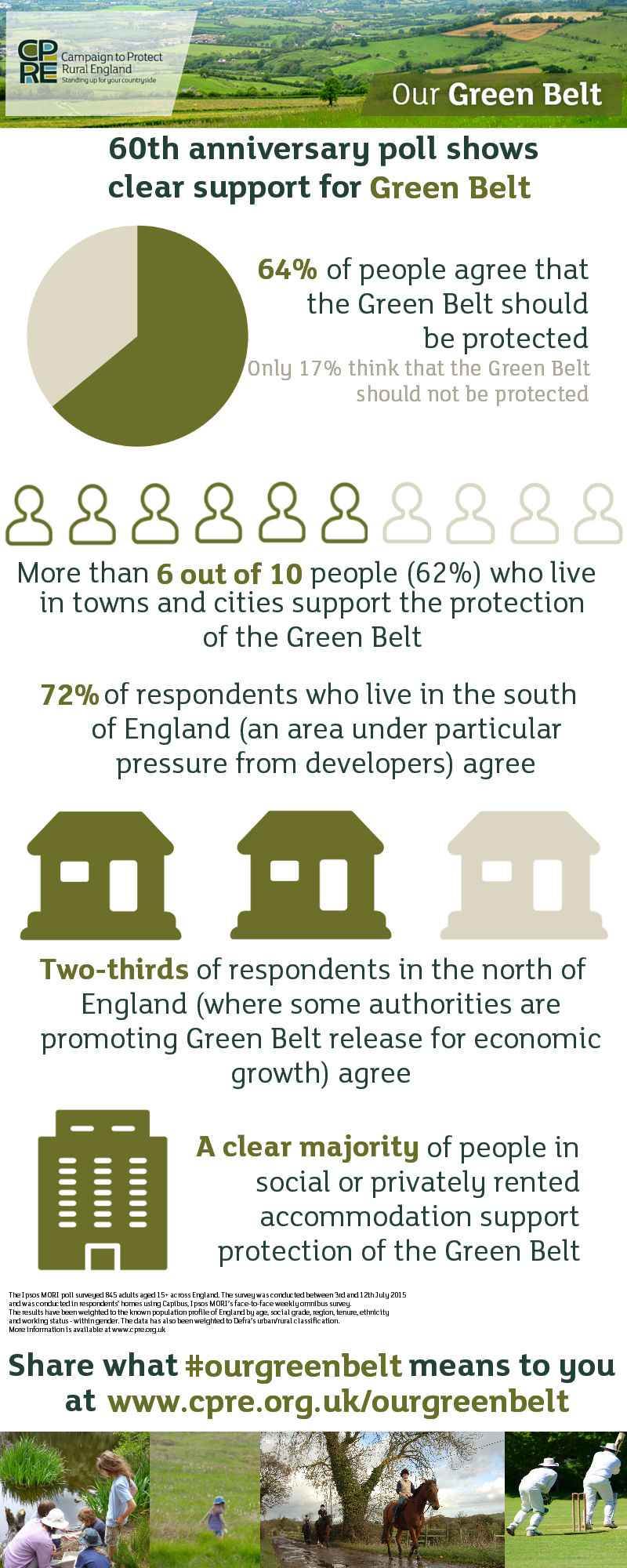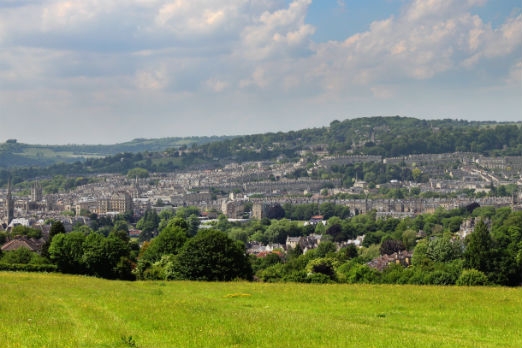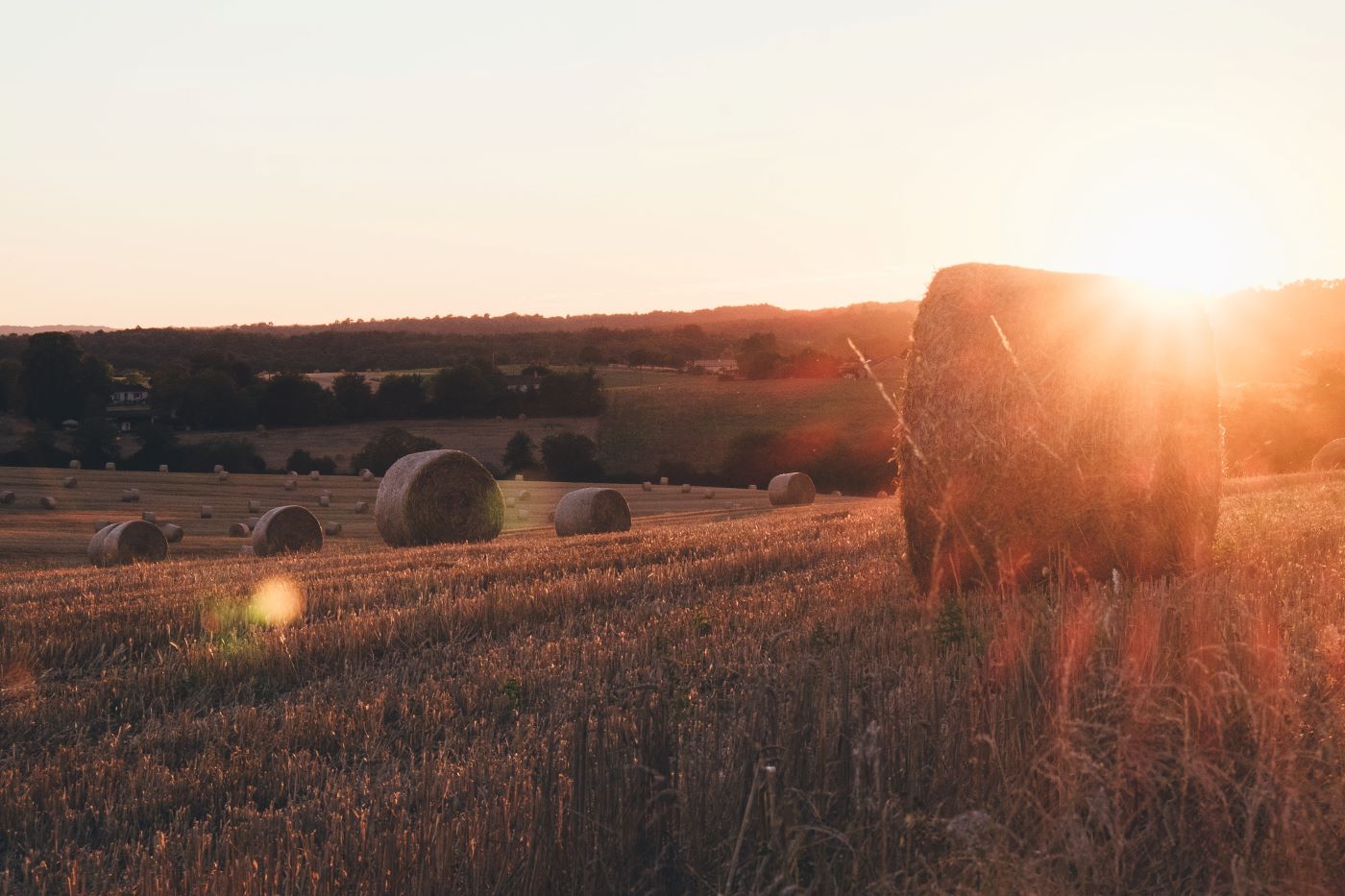On the 60th anniversary of Green Belt becoming government policy, a poll commissioned by the Campaign to Protect Rural England (CPRE) finds that nearly two-thirds of people surveyed believe that Green Belt land should not be built on [1,2].
The Ipsos MORI poll, published today, shows that 64% of people agree the Green Belt should be protected, while just 17% disagree [3]. Such strong support for Green Belt is demonstrated across a range of different groups, including people with children aged 5 and under, those renting from a local authority, and those on low incomes [4]. And more than six out of ten people (62%) who live in towns and cities support the protection of the Green Belt – a finding that casts doubt on the claims of critics that Green Belts do not benefit people who live in urban areas.
The anniversary poll comes just weeks after the Government re-emphasised its support for Green Belt protection at the launch of its Productivity Plan [5]. But despite this support and existing protections, local communities have repeatedly found themselves fighting proposals to build on Green Belt land. CPRE research shows that 226,000 houses are currently planned for Green Belt land [6].
In response to this threat, CPRE is launching a new campaign, Our Green Belt, which calls on the Government to:
- be more specific on the limited circumstances in which Green Belt boundaries can be changed through local plans;
- call in or direct local authorities to refuse damaging developments in the Green Belt that are not identified in existing local or neighbourhood plans; and
- target public funding, through organisations such as Natural England and Local Enterprise Partnerships, to increase the quality of and access to Green Belt.
CPRE’s campaign aims to show why people value the Green Belt by inviting the public to submit photos and stories to a digital wall showing how they use and experience it. CPRE is also publishing a Green Belt ‘myth-busting’ document to demonstrate why arguments to build on the Green Belt are misguided [7].
Shaun Spiers, chief executive of the Campaign to Protect Rural England (CPRE), says:
“We know that the Green Belt is loved by the general public and supported by politicians of all parties. Yet despite this, it is under greater threat than it has been in its 60 year history. Over 200,000 new houses are already planned for Green Belt land, and a growing number of think-tanks, developers and business groups are gunning for the Green Belt, arguing with very little evidence that we need to build on it in order to tackle the country’s housing crisis.
“The Green Belt is a fantastic British success story of which we should all be proud. It has both protected countryside and aided the regeneration of towns and cities across England. It is good for people’s well-being and quality of life; good for nature and wildlife; and it provides us with much of the food that we eat. Of course the country needs more homes, but we can get them without trashing the Green Belt.
“CPRE’s anniversary campaign is intended to rally all who care about our Green Belt. We want both national and local politicians to make clear that they recognise the importance of the Green Belt, and to commit to ensuring that planning authorities secure its protection.”
Further information on the Ipsos MORI poll
The poll results show that six times as many people strongly agree the Green Belt should be protected as those who strongly disagree.
Alongside 62% of poll respondents living in urban areas who want to see Green Belt protected, 72% of respondents who live in the south of England, an area under particular pressure from developers, agree. Two-thirds (66%) of respondents in the North of England (North East, North West and Yorkshire), an area where a number of local authorities are promoting Green Belt release by arguing it will boost economic growth, agree.
Green Belts are supported strongly regardless of whether people own or rent their own home. Developers have argued that Green Belts only benefit property owners. Yet a clear majority of people in social or privately rented accommodation support protection of Green Belt land (57% agree versus 18% who disagree).
Green Belt first became Government policy in 1955 - although some local authorities had used the term for land in their area before that date. In 2005, CPRE ran a poll for the 50th anniversary that contained similar questions with slightly different context for the Green Belt debate [8: phrasing of the 2005 question outlined in notes below]. While it is thus difficult to draw direct comparisons between the 2015 and 2005 polls, it could be remarked that the number of those supporting Green Belt protection appears to have fallen since 2005. CPRE believes that possible reasons for this include rising house prices and a static housebuilding sector.

Share this Image On Your Site
Notes to editors
[1] 3 August 2015 is the 60th anniversary of the circular from then housing minister Duncan Sandys MP that made Green Belts government policy.
[2] The Ipsos MORI poll surveyed 845 adults aged 15+ across England. The survey was conducted between 3rd and 12th July 2015 and was conducted in respondents’ homes using Capibus, Ipsos MORI’s face-to-face weekly omnibus survey. The results have been weighted to the known population profile of England by age, social grade, region, tenure, ethnicity and working status - within gender. The data has also been weighted to Defra’s urban/rural classification.
[3] The wording of the question and definition of Green Belt was as follows: In England, the Green Belt is agricultural and/or largely undeveloped land around or between large urban areas on which building is not allowed. The purposes of this, according to the National Planning Policy Framework, are to prevent large urban areas from spreading out or merging together, and in some cases to preserve the character of historic towns and cities. However, some people argue that it is necessary to build on parts of the Green Belt to meet housing and other needs and prevent other areas beyond the Green Belt from being built on. To what extent do you agree or disagree, in principle, that existing Green Belt land in England should be retained and not built on.
[4] The poll breakdowns for these groups are as follows: people with children aged 5 and under (60%); those renting from a local authority (58%); those on low incomes (62%).
[5] On the launch of the Productivity Plan, Business Secretary Sajid Javid said: "The green belt can be rightly protected. There is plenty of land which is not green belt that we can build on and which is suitable for housing and we need to get on with it. We need to find new ways to encourage it." (BBC News online, Planning shake-up to get more homes built, 10 July 2015).
In an op-ed for The Times, Prime Minister David Cameron and Chancellor of the Exchequer George Osborne also wrote: “We will always protect the green belt and make sure planning decisions are made by local people.” (David Cameron and George Osborne, The Times, Here’s how to build a homeowning Britain, 4 July 2015).
[6] These are updated figures for CPRE’s Green Belt under siege report that was released in March 2015.
[7] View Green Belt myths: CPRE's guide to what you need to know or download the PDF
[8] For the 2005 poll conducted by Ipsos MORI, CPRE’s question on Green Belt protection was phrased as thus: Green belts are defined areas of countryside surrounding our largest towns and cities where building of houses, out-of-town shopping centres, offices, warehouses and other kinds of development is usually not allowed. According to legislation the key reason green belts exist is to prevent urban areas spreading out across the countryside and eventually joining up. But some would argue that Green Belts are preventing necessary development from happening in the best place. How much, if at all, do you agree or disagree that green belt land should remain open and undeveloped, and building on it not allowed.
If you would like to speak to Shaun Spiers or another CPRE spokesperson about this in more detail then please contact Benjamin Halfpenny on 020 7981 2819.
The Campaign to Protect Rural England (CPRE) fights for a better future for the English countryside. We work locally and nationally to protect, shape and enhance a beautiful, thriving countryside for everyone to value and enjoy. Our members are united in their love for England’s landscapes and rural communities, and stand up for the countryside, so it can continue to sustain, enchant and inspire future generations. Founded in 1926, President: Sir Andrew Motion, Patron: Her Majesty The Queen.



